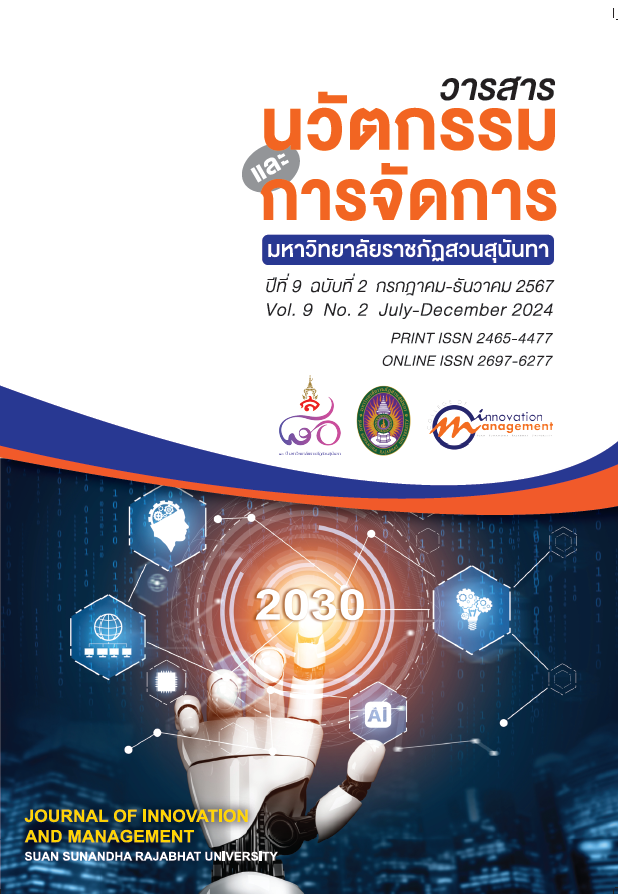Training Process to Develop Desirable Characteristics of Influencers on Youtube Platform
Keywords:
Influencer, Desirable Characteristics, Training processAbstract
The objectives of this research are 1) To analyze the desirable characteristics of influencers on YouTube platform, 2) To design and pilot a training process to develop the desirable characteristics of influencers on YouTube platform. It is qualitative research. Through 3 groups consist of 5 influencers, 3 Training specialists and 2 academics in the field of rhetoric by the research methodology, which Focus group and In-depth interviews in order to design the training program with 13 participants. The research results found that Desirable characteristics of influencers on the YouTube platform include 1) Identity 2) Consistency 3) Creativity 4) Content 5) Sincerity All 5 characteristics must include Ethos (trustworthiness) and Pathos (creating emotions for followers), Invention (Creating interesting content), Memory (speaking or showing to create recognition) are still important issues, as verbal and Non-Verbal communication, while Logos (rationality), Arrangement, Style, design, Delivery (systematic presentation) are slightly important. In addition, the training process was designed and piloted to develop the desirable characteristics of influencers on YouTube platform. An important feature in every training activity is Identity, followed by Creativity, Content, and Sincere. Consistency is found less often, only in some activities. The research results reflect the phenomenon changing. Including the importance and permanence of the theory that allows those interested in the influencer field to clearly apply it more effectively on the basis of rhetorical theory.
References
Ahmed, N. (2019). A study of ethos, pathos and logos in YouTube advertisements. IInternational Journal of Advertising.
Berger, A. A. (2015). Media and communication research methods: An introduction to qualitative and quantitative approaches. SAGE Publications.
Boonnuch, R. (2012). The Development and Training Affecting Employee Efficiency: A Case Study of the Provincial Electricity Authority, Region 1 (Central), Phra Nakhon Si Ayutthaya Province. Thesis of the Degree of Master Program in Business Administration. Bangkok: Rajamangala University of Technology Thanyaburi. (in Thai)
Chau, C. (2010). YouTube as a participatory culture. New Directions for Youth Development, 2010(128), 65–74. https://doi.org/10.1002/yd.376
Chantavanich, S. (2016). Data Analysis in Qualitative Research. 12th Edition. Bangkok: Chulalongkorn University Press. (in Thai)
Coassemble. (2021). Classroom training vs eLearning: The pros and cons. [Online]. Retrieved from https://www.coassemble.com/blog/classroom-training-vs-elearning-the-pros-and-con/
Global, L. (2016, February 23). 10 YouTube creators to watch in 2016. [Online]. Retrieved from https://www.theguardian.com/technology/2016/feb/23/10-youtube-creators-to-watch-in- 2016
Henry, J. S. (2009). Information and communication technology law. New Jersey: Moniclair University.
Henry Jenkins (2006). Convergence Culture: Where Old and New Media Collide. New York: New York University Press.
Kennedy, G. A. (2007). Aristotle on rhetoric: A theory of civic discourse. Oxford University Press.
Khansong, T. & Chaiwong, P. (2021). Rhetorical Strategies of Effective Product Presenters through Live Streaming on E-commerce Applications in Thailand. Journal of Communication Arts, Chulalongkorn University, 39(2), 45-65. (in Thai)
Nantasuthiwaree, W. (2015). Communication Strategies for Cosmetic Products through Social Media Net Idols and Purchasing Decisions of Thai Female Teenagers Bangkok: Bangkok University. (in Thai)
Porter, L. V. (2019). The Five Canons of Rhetoric as a Tool for Content Analysis of YouTube Videos. In The Handbook of Research on Digital Content, Mobile Learning, and Technology Integration Models in Teacher Education (pp. 264-282). IGI Global. doi:10.4018/978-1-5225- 7823-3.ch015
Ruangsri, K. (2017). Creativity and Message Design in TEDxBangkok. Thesis of the Degree of Master Program. Bangkok: Faculty of Communication Arts, Chulalongkorn University. (in Thai)
Rittveeradech, K. (2017). Strategies of Micro Influencers Affecting the Purchase Decisions of Organic Cosmetics through Online Media Among Women in Bangkok. Independent Study of the Degree of Master Program. Bangkok University, Bangkok. (in Thai)
Singler, B. (2017). Ethos, Pathos, Logos: The Three Pillars of Persuasion. Oxford Research Encyclopedia of Communication. doi: 10.1093/acrefore/9780190228613.013.281
Sriatsadaporn, R. (2015). Personality and Communication Competence: From Childhood to Working Age. Bangkok: Faculty of Communication Arts, Chulalongkorn University. (in Thai)
Sukprasit, N. & Kammadhi, P. (2020). Marketing Ethics of Online Influencers. Thesis of the Degree of Doctoral Program in Business Administration. Pathum Thani: Valaya Alongkorn Rajabhat University. (in Thai)
Suriwan, K. (2016). The Relationship between Key Opinion Leaders and Brand Consumers. Thesis of the Degree of Master Program. Bangkok: National Institute of Development Administration. (in Thai)
Sukvoraphirum, D. (2022). The Influence of Social Media Influencers on Youtube, Facebook, and Instagram on Cosmetic Product Purchase Decisions of People Aged 20-55 Living in Bangkok and Surrounding Areas. Independent Study of the Degree of Master Program. Bangkok: College of Management, Mahidol University. (in Thai)
Walther, J. B. (1996). Computer-mediated communication: Impersonal, interpersonal, and hyperpersonal interaction. Communication Research, 23(1), 3-43. doi: 10.1177/ 009365096023001001
Westenberg, W. (2016). The influence of YouTubers on teenagers. Thesis of the Degree of Master Program. Netherlands: University of Twente.
Zheng, D. (2020). The Challenges of Being a YouTuber. GigsDoneRight. [Online]. Retrieved from https://gigsdoneright.com/blog/the-challenges-of-being-a-youtuber/.
Downloads
Published
How to Cite
Issue
Section
License
Copyright (c) 2024 Journal of Innovation and Management

This work is licensed under a Creative Commons Attribution-NonCommercial-NoDerivatives 4.0 International License.
See Publication Ethics https://so03.tci-thaijo.org/index.php/journalcim/Ethics






